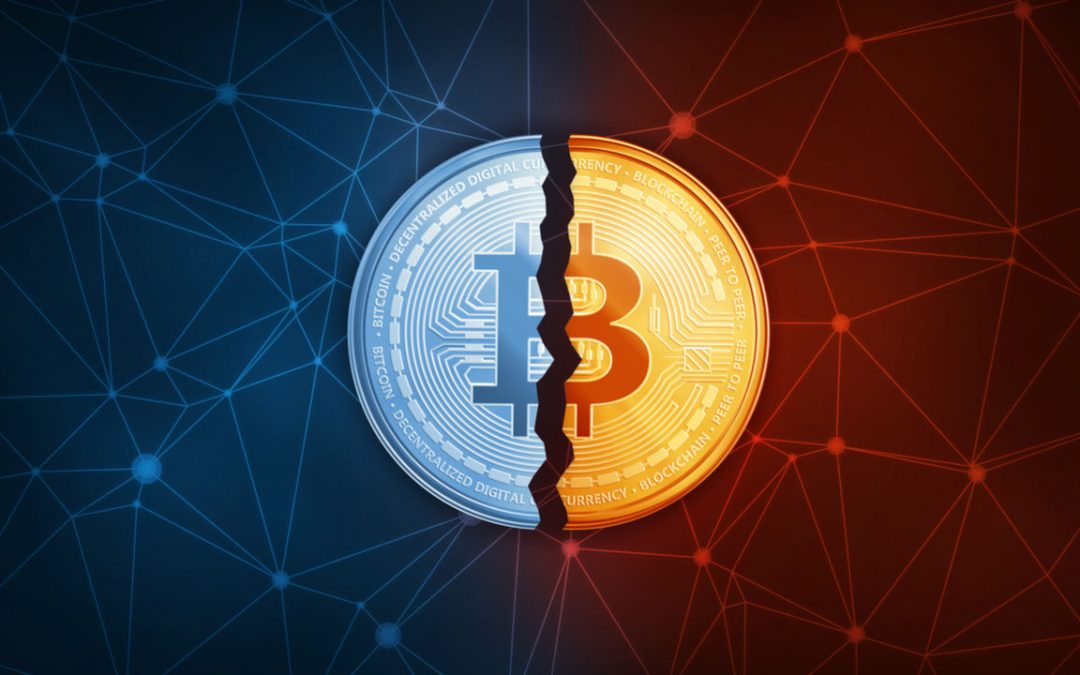Blockchain technology is open-source. Open-source means that anyone can take a look at the code and can even take it and make their own modifications. All of this goes along with the transparency aspect of the blockchain, which is a big part of the appeal.
However, what happens when somebody takes the existing open-source code of a blockchain and decides to modify it? This is what we consider a cryptocurrency fork.
The Technology Behind A Cryptocurrency Fork
To go deeper into a fork, we need first to understand blockchain technology.
The blockchain is quite literally a digital ledger of transactions. Every device that connects to the network is called a node because they each keep a copy of that ledger. Every copy of the ledger is exactly identical, as it was built under a strict set of rules.
It’s called a blockchain because transactions are stored into a block that must be verified by miners. Once a miner verifies a block, it is then placed onto everyone’s copy of the chain, hence the name blockchain.
However, if somebody is unhappy with the rules of a specific blockchain, they can alter the code to create their own blockchain. However, this causes a brand new ledger, also known as a fork. For example, we’ll take Bitcoin, and one of its forks, Bitcoin Cash.
The biggest issue with Bitcoin is its scalability. As of this writing, the Bitcoin blockchain can only process six or seven transactions a second. A standard payment processor, like Visa, can handle up to 24,000 a second. Since Bitcoin is vying to become a traditional payment processor, the fact that it can handle so few transactions every second is a big problem.
Any more than this and the Bitcoin network begins to congest and slow down massively. Transactions that may have taken 10 minutes to process can now take 20, so on and so forth.
Someone decided to work on this problem and modified the Bitcoin code to implement something called SegWit. SegWit changes the rules set by the Bitcoin network, allowing blocks to fit more transactions in them. When that code was modified, the blockchain essentially “split” into two. Bitcoin and Bitcoin Cash, while similar, are now two different blockchains.
However, it’s important to note that every single block before the point of the split is exactly the same on both blockchains. This allows for complete transparency and a detailed history of the network. Cryptocurrency forks aren’t always a good idea, and it’s important to look at the reasoning behind each one before getting involved.
Hard Forks and Soft Forks
I mentioned earlier that a fork changes the existing rules of a blockchain. However, sometimes changing the rules makes the old rules obsolete, while other times it doesn’t.
There are two different types of cryptocurrency forks, a soft fork, and a hard fork.
Depending on which fork it is, the network may require nodes and miners to upgrade their capabilities to continue participating on the new one. If not, they will be choosing to stick with the old blockchain instead.
Soft Fork
With a soft fork, the new rules are somewhat compatible with the old rules. This makes the new blockchain backward compatible with the previous one. It doesn’t require the entire network to upgrade, but a majority of them must for the changes to be enacted.
Hard Fork
A hard fork makes most or all of the previous rules obsolete. It is a permanent diversion, and every node on the network must upgrade to the new policies, software, and wallets.
A hard fork generally consists of a new work algorithm or a brand new feature.
Popular Cryptocurrency Forks
There are all sorts of different forks in existence. Some are popular while others aren’t so much. Here are some of the most well-known forks on the market:
Ethereum Byzantium Fork
The Byzantium hard fork was an update to the Ethereum blockchain that was formed at block number 4,370,000. With it came nine Ethereum Improvement Protocols (EIPs) each of which targeting Ethereum’s scalability, security, and privacy elements.
It incorporates parallel processing to help create separate, second layer blockchains that would increase the speed of payment processing.
The fork will also include zk-snarks support, which is a cryptography enhancement that allows users to prove that they own a private key without having to reveal personal information to do so.
Byzantium will also reduce the block reward from 5 ether to 3 ether, and is leading the way to the complete removal of the proof-of-work algorithm and move into a proof-of-stake.
Ethereum Classic Hard Fork
Back in 2016, there was only one version of Ethereum. However, the community argued amongst themselves in implementing a Decentralized Autonomous Organization (DAO) which intended to increase the potential of smart contracts.
During this time, a white paper was published that detailed the weak points in the DAO, of which someone took advantage of. A hacker stole $50 million in Ether and moved to a separate account. However, they couldn’t do anything with that money, as the DAO required 28 days to pass before they can withdraw the transaction.
So, the community had 28 days to do something to get the Ether back. There was a battle between rolling back the Ethereum blockchain and simply hard forking the network.
Rolling back the network would go against the permanent nature of the blockchain, so the team finally decided on a hard fork to solve the problem. With the hard fork, the new Ethereum network changed the Ether criteria, preventing the hacker from doing anything with the money.
The old blockchain became Ethereum Classic and still sees support. However, the hard forked blockchain is the Ethereum we know and love today and sees the most support.
As you can see, a cryptocurrency fork can happen for all sorts of reasons. Sometimes someone has a good idea, while other times a fork is necessary for security. Regardless, forks are a great way to ensure longevity while using blockchain technology. Sometimes, a simple update isn’t enough.












